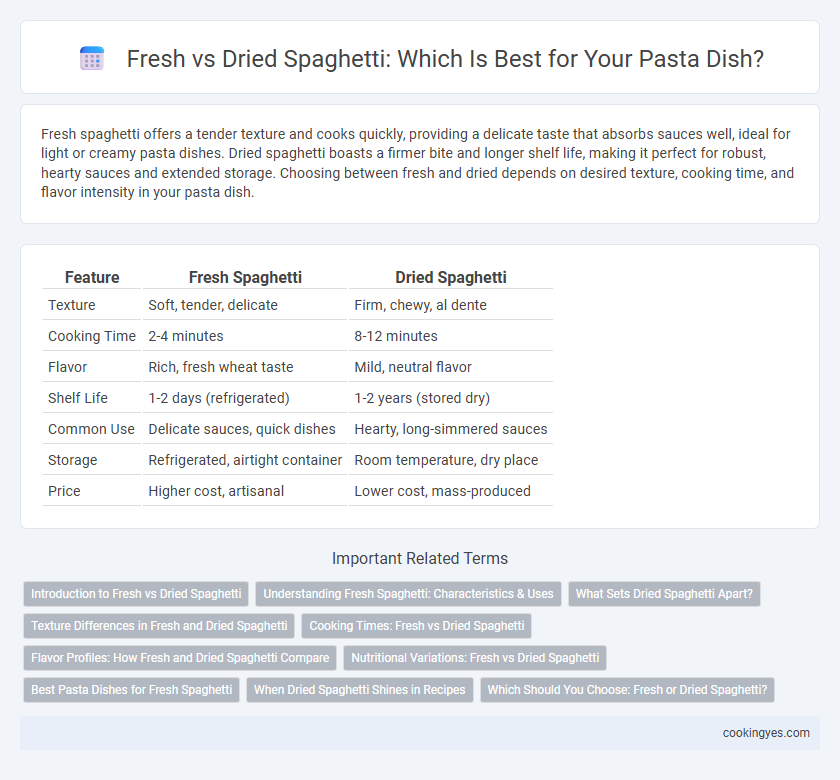Fresh spaghetti offers a tender texture and cooks quickly, providing a delicate taste that absorbs sauces well, ideal for light or creamy pasta dishes. Dried spaghetti boasts a firmer bite and longer shelf life, making it perfect for robust, hearty sauces and extended storage. Choosing between fresh and dried depends on desired texture, cooking time, and flavor intensity in your pasta dish.
Table of Comparison
| Feature | Fresh Spaghetti | Dried Spaghetti |
|---|---|---|
| Texture | Soft, tender, delicate | Firm, chewy, al dente |
| Cooking Time | 2-4 minutes | 8-12 minutes |
| Flavor | Rich, fresh wheat taste | Mild, neutral flavor |
| Shelf Life | 1-2 days (refrigerated) | 1-2 years (stored dry) |
| Common Use | Delicate sauces, quick dishes | Hearty, long-simmered sauces |
| Storage | Refrigerated, airtight container | Room temperature, dry place |
| Price | Higher cost, artisanal | Lower cost, mass-produced |
Introduction to Fresh vs Dried Spaghetti
Fresh spaghetti offers a tender texture and cooks quickly due to its higher moisture content, making it ideal for delicate sauces and quick meals. Dried spaghetti, with its low moisture and lengthy shelf-life, provides a firmer bite and is better suited for robust, hearty sauces. Both types maintain essential durum wheat semolina, influencing cooking time and texture preferences in pasta dishes.
Understanding Fresh Spaghetti: Characteristics & Uses
Fresh spaghetti features a tender texture and shorter cooking time compared to dried pasta, making it ideal for delicate sauces like Alfredo or seafood-based recipes. Its higher moisture content enhances the absorption of light, creamy sauces, preserving the pasta's elasticity and smooth mouthfeel. Chefs often prefer fresh spaghetti for quick, gourmet dishes that emphasize subtle flavor profiles and a soft bite.
What Sets Dried Spaghetti Apart?
Dried spaghetti is characterized by its long shelf life and firm texture, achieved through a low-temperature drying process that preserves gluten structure. Unlike fresh spaghetti, dried varieties absorb sauces more effectively and maintain a consistent bite when cooked al dente. Industrial drying ensures uniformity in shape and thickness, making dried spaghetti a reliable choice for traditional pasta dishes.
Texture Differences in Fresh and Dried Spaghetti
Fresh spaghetti offers a tender and slightly chewy texture due to its higher moisture content, which allows it to cook quickly and absorb sauces more effectively. Dried spaghetti, on the other hand, provides a firmer, al dente bite with a more pronounced resistance when chewed, making it ideal for robust pasta dishes that benefit from extended cooking times. The choice between fresh and dried spaghetti significantly influences the overall mouthfeel and sauce adherence in pasta recipes.
Cooking Times: Fresh vs Dried Spaghetti
Fresh spaghetti typically cooks in just 2 to 4 minutes due to its higher moisture content and tender texture, providing a delicate bite that complements light sauces. Dried spaghetti requires a longer cooking time, usually around 8 to 12 minutes, as the low moisture density demands more time to soften, making it ideal for hearty, robust sauces. Adjusting cooking times based on the spaghetti type ensures the perfect al dente texture essential for an authentic pasta dish experience.
Flavor Profiles: How Fresh and Dried Spaghetti Compare
Fresh spaghetti offers a delicate texture and a subtle, slightly sweet wheat flavor that enhances light sauces and simple preparations. Dried spaghetti provides a denser bite with a more robust, concentrated wheat taste, ideal for hearty, tomato-based sauces. Choosing between fresh and dried spaghetti depends on the desired sauce compatibility and the intensity of flavor preferred in the pasta dish.
Nutritional Variations: Fresh vs Dried Spaghetti
Fresh spaghetti contains higher moisture content and retains more vitamins like B-complex and antioxidants compared to dried spaghetti, which undergoes nutrient loss during dehydration. Dried spaghetti typically has a longer shelf life and a more concentrated carbohydrate profile, making it a calorie-dense option. Both types offer similar protein levels, but fresh pasta may provide slightly better digestibility due to its hydration and softer texture.
Best Pasta Dishes for Fresh Spaghetti
Fresh spaghetti offers a tender texture that absorbs sauces more effectively, making it ideal for delicate pasta dishes like carbonara and seafood linguine. Its higher moisture content allows for quicker cooking times and a richer mouthfeel, enhancing the flavors of light cream or olive oil-based sauces. Recipes such as fresh tomato basil pasta or garlic butter spaghetti particularly benefit from the supple consistency of fresh pasta compared to dried varieties.
When Dried Spaghetti Shines in Recipes
Dried spaghetti excels in recipes requiring long cooking times, such as baked pasta dishes or hearty sauces that benefit from its firm texture, preventing overcooking and mushiness. Its low moisture content offers extended shelf life and better absorption of robust flavors like tomato-based ragu or spicy arrabbiata. When precision and convenience matter, dried spaghetti consistently delivers a reliable al dente bite, making it ideal for traditional Italian dishes like spaghetti carbonara and spaghetti aglio e olio.
Which Should You Choose: Fresh or Dried Spaghetti?
Fresh spaghetti offers a tender texture and cooks faster, ideal for delicate sauces like carbonara, while dried spaghetti provides a firmer bite and longer shelf life, perfect for robust sauces such as marinara or Bolognese. Choosing between fresh or dried depends on cooking time, desired texture, and sauce pairing, with dried spaghetti favored for its versatility and convenience. For authentic Italian dishes, fresh spaghetti is preferred in light, quick recipes, whereas dried spaghetti excels in hearty, slow-cooked meals.
Fresh Spaghetti vs Dried Spaghetti for Pasta Dish Infographic

 cookingyes.com
cookingyes.com